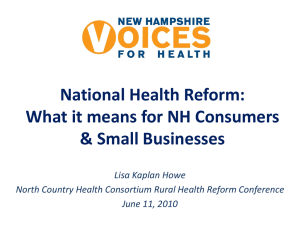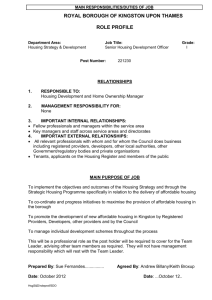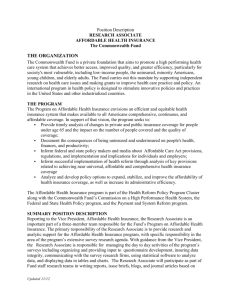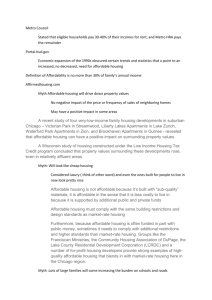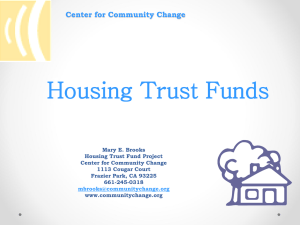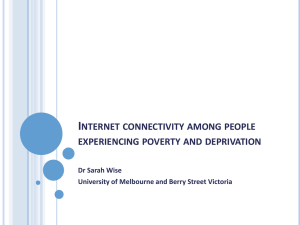Developing Campaigns for Issues and Projects
advertisement
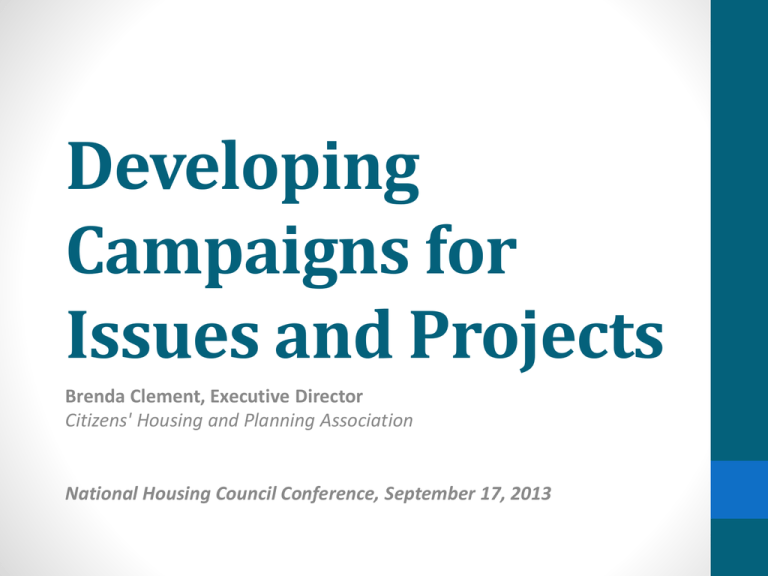
Developing Campaigns for Issues and Projects Brenda Clement, Executive Director Citizens' Housing and Planning Association National Housing Council Conference, September 17, 2013 Agenda • home@last: 2005 • Protect Affordable Housing Massachusetts:2009 • Vote “No” on 2: 2010 • Welcome Home: 2012 home@Last: 2005 Protect Affordable Housing Campaign: 2009 Vote “No” on 2 Campaign Vote “No” on 2 Campaign Accomplishments • Over 3,000 volunteers sent “dear friend” messages, displayed a campaign sign, staffed an information table at a community event, phone banked, or participated in an online “Rapid Response” Team. • 4,500 lawn signs and 1.2 million palm cards were distributed. • Volunteers covered 650 polling locations in more than 150 cities and towns. • Direct outreach was made to more than 50,000 residents of affordable housing. • 145 letters to the editor were published in 47 newspapers, op-eds were published in 45 newspapers, and 62 newspapers editorialized in support of No on 2. Lessons Learned • Have consistent, concise messages • Public opinion polling is critical • Build diverse coalition early; capitalize on existing Relationships • Maintain close, in-house staffing of campaign • Use data to support claims made to the media • Involve real people as voices and faces of campaign • Different messages for different audiences Welcome Home • On November 2, 2010, Massachusetts voters soundly defeated the repeal of the state’s affordable housing law, known as Chapter 40B. In response, CHAPA launched Welcome Home Massachusetts in early 2012. • Over the course of three years, Welcome Home Massachusetts will: (1) increase the amount of affordable housing in urban, suburban and rural communities, and (2) provide support to local groups so they can advance affordable housing initiatives in their communities. Welcome Home Massachusetts focuses on three primary strategies: Communications and Messaging: • Statewide messaging and media campaign highlighting the need for affordable housing. • Written and online materials tailored to build local support for affordable housing among municipal officials, town meeting members, civic leaders, and local media. • Resources such as the “faces and places” of affordable housing and the connection between affordable housing and a vibrant economy. • A statewide “call to action” will elevate awareness of affordable housing needs and solutions in every city and town. Education and Information: • A new web site features an extensive online guide to implementing local housing strategies. • Other features of the web site will include: fact sheets on the importance of affordable housing; photos and descriptions of exemplary developments; short videos of residents living in affordable housing; connections to an active statewide network of supporters (including use of social media); localized housing and census data for every municipality; updates on local activities and meetings; a resource directory of local housing committees and partnerships; a blog on successful initiatives; and an “ask the experts” section staffed by housing professionals. Local Support: • A steering committee will select up to 15 diverse communities across the state (5 per year) to receive in-depth assistance so that these groups can achieve local affordable housing goals. Assistance may include funding a local organizer, assisting with a media strategy, or developing educational materials. • We will evaluate the progress of these local campaigns to determine what strategies have been most successful. Brenda Clement Executive Director, Citizens' Housing and Planning Association bclement@chapa.org Citizens’ Housing and Planning Association 18 Tremont Street, Suite 401 Boston, MA 02108 t. 617-742-0820 f. 617-742-3953 www.chapa.org


